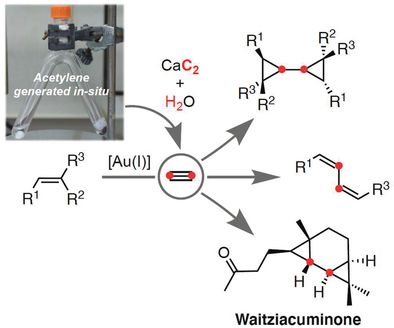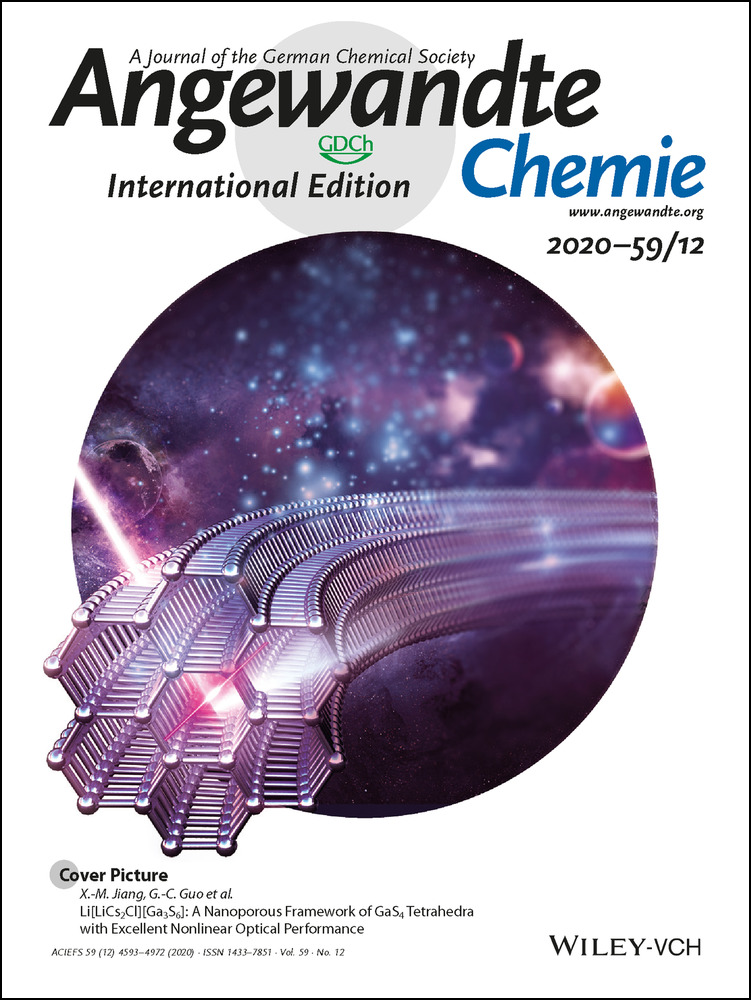Acetylene as a Dicarbene Equivalent for Gold(I) Catalysis: Total Synthesis of Waitziacuminone in One Step
Graphical Abstract
Abstract
The gold(I)-catalyzed reaction of acetylene gas with alkenes leads to (Z,Z)-1,4-disubstituted 1,3-butadienes and biscyclopropanes depending on the donor ligand on gold(I). Acetylene was generated in situ from calcium carbide and water in a user-friendly procedure. Reaction of acetylene with 1,5-dienes gives rise stereoselectively to tricyclo[5.1.0.02,4]octanes. This novel double cyclopropanation has been applied to the one step total synthesis of the natural product waitziacuminone from acetylene and geranyl acetone.
The last decade has witnessed the impact of gold(I) catalysis for the construction of complex organic frameworks,1 particularly in the realm of the total synthesis of natural products.2 However, while gold(I)-catalyzed intramolecular transformations usually perform outstandingly, their intermolecular versions are more challenging.3 Our group demonstrated that the intermolecular reaction between terminal alkynes and alkenes 1 leads selectively to cyclobutenes 3, although 1,3-dienes 4 were also formed with ortho-substituted aryl alkynes (Scheme 1).4 These two transformations proceed via cyclopropyl gold carbenes 2 that undergo ring expansion or formal 1,3-C migration to afford cyclobutenes 3 or 1,3-dienes 4, respectively.4c The synthesis of cyclobutenes by [2+2] cycloaddition is a general reaction that can be carried out enantioselectively,5 although alkyl-substituted alkynes are poorly reactive partners.
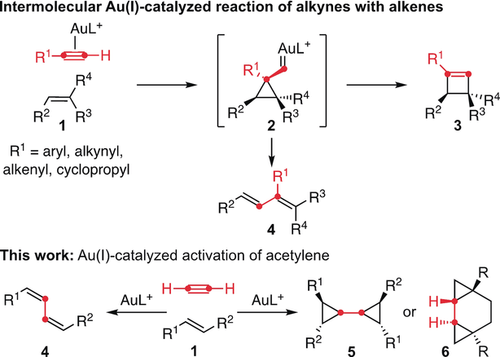
General pathways for the reaction of alkynes with alkenes catalyzed by gold(I) catalysts and transformation of acetylene into Z,Z-dienes 4, biscyclopropanes 5, or tricyclo[5.1.0.02,4]octanes 6.
Acetylene is a commodity feedstock for the production of vinyl chloride and other products.6 In stark contrast, its use in homogeneous gold catalysis, especially for the assembly of complex structures, is very limited. So far, acetylene has not been used for the preparation of cyclobutenes 3 or dienes 4. Interestingly, cyclopropyl gold carbenes 2 with R1=H, which formally correspond to those that would be generated by reaction of acetylene with an alkene, were shown to be intermediates in the decarbenation of a cyclopropyl-substituted cycloheptatriene.4c, 7 Herein, we report the use of acetylene gas in intermolecular gold(I)-catalyzed reactions leading, stereoselectively, to Z,Z-dienes 4, biscyclopropanes 5, and tricyclo[5.1.0.02,4]octanes 6 (Scheme 1). Acetylene was conveniently produced in situ in small quantities from calcium carbide and water8 using a Y shaped two-chamber flask.9
Several gold(I) catalysts were initially tested in the reaction of acetylene with trans-stilbene (1 a) (Table 1). Gold(I) complexes A and B with JohnPhos as the ligand (Table 1, entries 1 and 2) led to mixtures of 1,3-diene 4 a and biscyclopropane 5 a. While complexes C and D with tBuXPhos as ligand delivered selectively Z,Z-diene 4 a (Table 1, entries 3 and 4), IPr gold(I) complexes E and F favored the formation of 5 a (Table 1, entries 5 and 6).10 As we have observed before,4c, 11 complexes D and F with BArF4− as the anion outperform those with SbF6−.
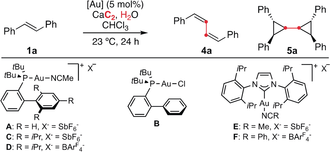
Entry |
[Au] |
4 a Yield [%][a] |
5 a Yield [%][a] |
|---|---|---|---|
1 |
A |
24 |
11 |
2 |
B[b] |
15 |
41 |
3 |
C |
7 |
0 |
4 |
D |
25 |
<1 |
5 |
E |
<1 |
6 |
6 |
F |
1 |
56 |
- [a] Yield determined by 1H NMR using diacetyl benzene as internal standard. [b] Reaction with equimolar amounts of B and NaBArF4.
The catalytic system based on complex tBuXPhos-gold(I) complex D was further optimized delivering the diene 4 a in 27 % yield (Scheme 2). Substrates with a methyl or tert-butyl group in para position of the stilbene aryl group lead to products 4 b and 4 c with similar results. Noteworthy, the yield with stilbene 1 d with ortho-methyl groups was significantly higher. This is in line with our observations in the reactions of alkenes with aryl alkynes bearing ortho-substituents.4c The transformation of 1-naphtyl derivative 1 e gave also small amounts of E,E-4 e in addition to the Z,Z-isomer, usually observed as the sole product. Stilbene 1 f with 3,5-disubstituted aryls afforded diene 4 f in moderate yield. The low to moderate yields result from the competing reaction of 1,3-dienes 4 with acetylene leading to oligomerization. Thus, we detected products containing up to 4 units of acetylene by MALDI analysis of the crude reaction mixtures (Scheme 2).12
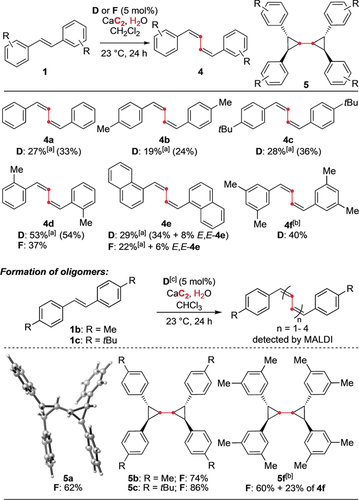
Synthesis of dienes 4 and biscyclopropyl compounds 5 from acetylene and stilbenes 1 a–f and oligomerization experiments. Yields of isolated products (yields determined by 1H NMR using diacetyl benzene as internal standard in parenthesis); 5 a is shown as a CYLview depiction of the X-ray crystal structure. [a] Isolated as a mixture with starting material. [b] Reaction carried out in chloroform, at 40 °C. [c] Reaction with equimolar amounts of tBuXPhosAuCl and NaBArF4.
Optimization of the catalytic system using complex F led to biscyclopropyl compounds 5 a–c and 5 f in good yields in a biscyclopropanation, in which acetylene behaves as a dicarbene equivalent (Scheme 2). Remarkably, only one diastereomer was observed by NMR, chiral supercritical fluid chromatography and reverse phase ultra-high-performance liquid chromatography. The relative configuration of 5 a was confirmed by X-ray diffraction.13
The formation of biscyclopropyl derivatives 5 from acetylene is not only applicable to aryl-substituted alkenes but could be also carried out with cyclooctene to form 5 g (Scheme 3). In a competition experiment with equimolar amounts of stilbene 1 c and cyclooctene 1 g, the cross-biscyclopropane 5 h was obtained together with biscyclopropanes 5 c and 5 g.
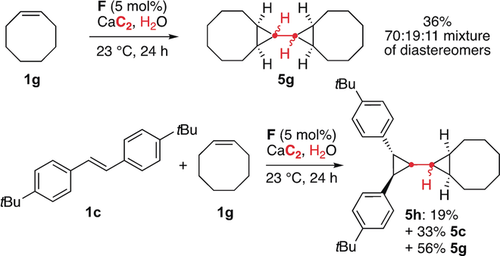
Biscyclopropanation of cyclooctene.
To understand the high selectivity on the formation of the meso-biscyclopropyl products 5 a–c and 5 f, we carried out a DFT study of the reaction of trans-stilbene (1 a) with (η2-alkyne)gold(I) complex Int1 a (Scheme 4).12 As we have shown before,4c cyclopropyl gold carbene Int2 a is formed in an exergonic process and it can react further with a second molecule of 1 a to form Int3 a or Int4 a. Formation of Int4 a through TSInt2a-Int4a, which leads to meso-5 a, is 2.7 kcal mol−1 more favorable than formation of Int3 a, in agreement with the experimental results.
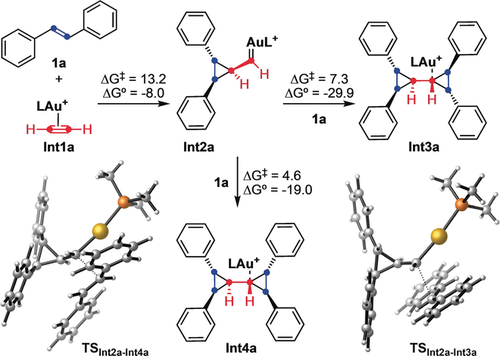
Calculated formation of different diastereomers of biscyclopropyl products. L=PMe3. DFT calculations performed with M06-D3/6-31G(d) (C, H, P) and SDD (Au) in CH2Cl2 (SMD). Free energies in Kcal mol−1.
Furthermore, 1,5-dienes 7 a–e react with acetylene to form tricyclo[5.1.0.02,4]octanes 6 a–e as single diastereomers in the presence of catalyst D (Scheme 5). The relative configuration of 6 a was assigned by X-ray diffraction.13
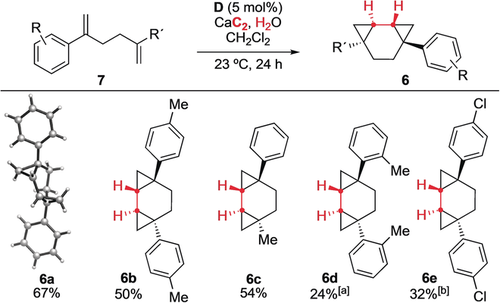
Synthesis of tricyclo[5.1.0.02,4]octanes 6. [a] Isolated as a mixture with various alkene side products [b]. Crude product resubmitted to reaction with acetylene and catalyst D two additional times (total 72 h reaction time).
This biscyclopropanation of 1,5-dienes was applied to the first total synthesis of waitziacuminone (9),14, 15 a sesquiterpene isolated from the aerial parts of Waitzia acuminata, known as orange immortelle, an annual herb native to Australia (Scheme 6). With geranyl acetone (8) as the substrate and catalyst F, the natural product was produced as a racemate in only one step as a single diastereomer. The relative configuration of waitziacuminone (9) was confirmed by X-ray diffraction of its crystalline 2,4-dinitrophenylhydrazone 10.13

One step total synthesis of (±)-waitziacuminone (9) and X-ray crystal structure of its 2,4-dinitrophenylhydrazone 10 (CYLview depiction).
The different pathways for the reaction between acetylene and geranyl acetone (8) were studied computationally12 (Scheme 7). In principle, four possible cyclopropyl gold carbenes can be formed by reaction of both alkenes of 8 with (η2-alkyne)gold(I) complex Int1 a. The most favorable cyclopropanation gives Int6 a, which immediately undergoes a second cyclopropanation through TSInt6a-Int7a to form Int7 a, and finally waitziacuminone (9). This pathway could compete with the initial cyclopropanation of the internal alkene of 8 leading to Int5 a, which would similarly undergo an intramolecular cyclopropanation to form Int7 a. The two other alternative pathways have slightly higher activation energies and the corresponding intermediates Int5 b and Int6 b would be unproductive, since the second cyclopropanation would generate a highly strained tricyclo[5.1.0.02,4]octane bearing two trans-fused cyclopropanes, as shown by the high activation energies of these endergonic processes.

Different mechanistic pathways to form Int7 a,b by double cyclopropanation reactions. L=PMe3. DFT calculations performed with M06-D3/6-31G(d) (C, H, P, O) and SDD (Au) in CH2Cl2 (SMD). Free energies in kcal mol−1.
In conclusion, we have developed catalytic systems for the incorporation of acetylene gas into complex frameworks by means of gold(I) catalysis under experimentally very simple conditions. Acetylene is activated by gold(I) as a dicarbene equivalent that allows for the stereoselective synthesis of Z,Z-dienes 4, biscyclopropyl compounds 5, and tricyclo[5.1.0.02, 4]octanes 6. The latter transformation was applied to the first total synthesis of the sesquiterpene waitziacuminone (9) by the stereoselective formation of four C−C bonds and three rings in a single step.
Acknowledgements
We thank the Agencia Estatal de Investigación (AEI)/FEDER, UE (CTQ2016-75960-P, FPU predoctoral fellowship to H.A.-R. and Severo Ochoa predoctoral fellowship to M.E.d.O.), the European Research Council (Advanced Grant No. 835080), the AGAUR (2017 SGR 1257), and CERCA Program/Generalitat de Catalunya for financial support. D.S. acknowledges the receipt of a postdoctoral fellowship from the Deutsche Forschungsgemeinschaft. We also thank the ICIQ X-ray diffraction unit and Dr. Rémi Blieck for helpful discussions.
Conflict of interest
The authors declare no conflict of interest.



